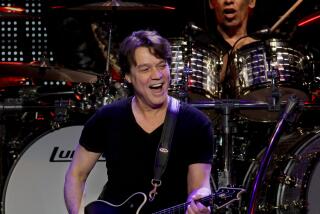Exploring Fascinating Rhythms
- Share via
Bassist Dave Holland, in his low-keyed, let’s-focus-on-the-music manner, consistently seems to lead groups that manage to appeal on several levels. “Prime Directive” (*** 1/2, ECM Records) is the latest installment, one that is characteristic of his expansive skills as a leader and a player.
Consider the album’s many appealing qualities. Several of the tunes explore Holland’s fascination with unusual rhythmic meters. But they are never presented in showoff fashion; he avoids the all-too-common and obvious emphasis upon a repetitious rhythmic pattern (coupled with an undercurrent of tension over whether everyone will arrive back at the first beat of the bar together). Instead, Holland--in original pieces such as “Jugglers Parade” and “Make Believe”--employs 5/4 and 9/8 rhythms to generate a surging undercurrent, a disjunct flow of emphasis that is only one element in a multihued musical picture.
Then there is the accompanying instrumentation, with almost every song making use of the unusual tonal combination of Chris Potter’s saxophones, Robin Eubanks’ trombone and Steve Nelson’s vibraphone. And, finally, there are the superb solo strengths of the individual players--including drummer Billy Kilson--with Potter’s alto work a standout among some very high level improvising.
Speaking of alto saxophonists, Greg Osby, like bassist Holland, has also been a consistently eclectic artist via a series of albums expanding into funk, rap and R&B.; In “The Invisible Hand” (*** 1/2, Blue Note), however, he moves into an arena reminiscent of his ‘80s work with the edgy, outside music of the M-Base Collective.
His associates include, in an amazingly unlikely combination, guitarist Jim Hall and pianist Andrew Hill, as well as saxophonist Gary Thomas, bassist Scott Colley and drummer Teri Lyne Carrington. And the real fascination of the album is the interaction among three utterly different stylists--Osby, Hall and Hill--and the effectiveness with which they blend with one another. The result is one of Osby’s better outings, one in which he allows his own wide-ranging musical perspective to encounter, and be stimulated by, some new and challenging creative partnerships.
Pat Metheny is a guitarist who has never hesitated to take on the difficult task of trio playing (with bass and drum). He has reveled, in fact, in the thorny responsibilities of functioning as both lead and harmony instrument, a job that has not always been welcomed by some guitarists. But on “Trio--00” (*** 1/2, Warner Bros.), Metheny is in exceptionally fine form, in part perhaps due to the presence of bassist Larry Grenadier and drummer Bill Stewart, two particularly empathetic musical associates.
Metheny’s performances, in fact, should calm the doubts of anyone who has speculated that his commercial success and/or flirtations with electronics have in any way diminished his credentials as a serious jazz artist. His version of “Giant Steps,” for example, invests the familiar Coltrane line with an interpretation that reaches beyond the usual emphasis upon its rapid-fire harmonic changes. “I’ve Got a Lot of Livin’ to Do” (from “Bye Bye Birdie”) resonates with references to Joe Pass and Jim Hall. And Metheny’s acoustic guitar work on his own compositions--”Just Like the Day,” “We Had a Sister” (originally written for Joshua Redman) and “Travels”--are as diverse as they are articulate, so well-done that one wishes he would devote more time to this expressive format.
The partnership of saxophonist Joe Maneri, his violinist son Mat Maneri and bassist Barre Phillips on “Tales of Rohnlief” (** 1/2, ECM Records) reaches into a far different musical universe. The CD’s opening track, in fact, begins with some odd vocalizing from the elder Maneri that is bizarre enough to make most jazz listeners quickly move on. A bit of patience, however, delivers a collection of freestyle improvising reminiscent of the experimentation taking place in the ‘60s. This is music as atmosphere, as sound for imaginary pictures, as an expression of spontaneous immediacy. As such it can be more fascinating to the players than to their audience, a problem endemic to much of the vanguard music of the second half of the 20th century, in both jazz and classical arenas.
More to Read
The biggest entertainment stories
Get our big stories about Hollywood, film, television, music, arts, culture and more right in your inbox as soon as they publish.
You may occasionally receive promotional content from the Los Angeles Times.










